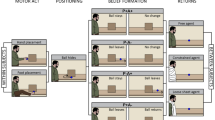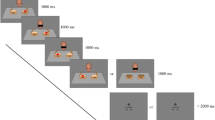Abstract
Theory of Mind (ToM) or mentalizing refers to the ability to attribute mental states (such as desires, beliefs or intentions) to oneself or others. ToM has been argued to operate in an explicit and an implicit or a spontaneous way. In their influential paper, Kovács et al. (Science 330:1830–1834, 2010) introduced an adapted false belief task—a ball detection task—for the measurement of spontaneous ToM. Since then, several studies have successfully used versions of this paradigm to investigate spontaneous ToM. This paradigm has, however, been criticized by Phillips et al. (Psychol Sci 26(9):1353–1367, 2015), who argue that the effects are fully explained by timing artifacts in the paradigm, namely differences in timing of the attention check. The main objective of the current study is to test this attention-check hypothesis. An additional aim was to relate the findings to autism spectrum disorder (ASD) symptomatology in our neurotypical sample, as ASD has been linked to deficits in spontaneous mentalizing. We applied an adjusted version of the paradigm in which the timings for all conditions are equalized, ruling out any potential timing confounds. We found significant main effects of own and agent beliefs on reaction times. Additionally, we found a significant ‘ToM-effect’: When participants believe the ball is absent, they detect the ball faster if the agent believes the ball would be present rather than absent, which refers to the original effect in the paper of Kovács et al. (2010), taken as evidence for spontaneous ToM and which was contested by Phillips et al. (2015). Our findings cannot be explained by the attention-check hypothesis. Effects could not be associated with ASD symptoms in our neurotypical sample, warranting further investigation on the link between spontaneous mentalizing and ASD.


Similar content being viewed by others
References
Apperly, I. A., & Butterfill, S. A. (2009). Do humans have two systems to track beliefs and belief-like states? Psychological Review,116(4), 953–970. https://doi.org/10.1037/a0016923.
Bagby, R. M., Parker, J. D. A., & Taylor, G. J. (1994). The twenty-item Toronto Alexithymia Scale. Item selection and cross-validation of the factor structure. Journal of Psychosomatic Research,38, 23–32.
Bardi, L., Desmet, C., Nijhof, A., Wiersema, J. R., & Brass, M. (2017). Brain activation for spontaneous and explicit mentalizing in adults with autism spectr. Social Cognitive and Affective Neuroscience,12(3), 391–400. https://doi.org/10.1093/scan/nsw143.
Baron-Cohen, S., Wheelwright, S., Skinner, R., Martin, J., & Clubley, E. (2001). The Autism Spectrum Quotient: Evidence from Asperger syndrome/high functioning autism, males and females, scientists and mathematicians. Journal of Autism and Developmental Disorders,31(1), 5–17. https://doi.org/10.1023/A:1005653411471.
Clements, W. A., & Perner, J. (1994). Implicit understanding of belief. Cognitive Development,9(4), 377–395. https://doi.org/10.1016/0885-2014(94)90012-4.
Constantino, J. N., & Gruber, C. P. (2005). Social responsiveness scale (SRS). Los Angeles, CA: Western Psychological Services.
Deschrijver, E., Bardi, L., Wiersema, J. R., & Brass, M. (2016). Behavioral measures of implicit theory of mind in adults with high functioning autism. Cognitive Neuroscience, 7(1–4). https://doi.org/10.1080/17588928.2015.1085375.
Frith, U. (2012). Why we need cognitive explanations of autism. Quarterly Journal of Experimental Psychology,65(11), 2073–2092. https://doi.org/10.1080/17470218.2012.697178.
Hill, E. L., & Frith, U. (2003). Understanding autism: Insights from mind and brain. Philosophical Transactions of the Royal Society B: Biological Sciences,358(1430), 281–289. https://doi.org/10.1098/rstb.2002.1209.
Hoekstra, R. A., Bartels, M., Cath, D. C., & Boomsma, D. I. (2008). Factor structure, reliability and criterion validity of the autism-spectrum quotient (AQ): A study in Dutch population and patient groups. Journal of Autism and Developmental Disorders,38(8), 1555–1566. https://doi.org/10.1007/s10803-008-0538-x.
Kovács, Á. M., Kühn, S., Gergely, G., Csibra, G., & Brass, M. (2014). Are all beliefs equal? Implicit belief attributions recruiting core brain regions of theory of mind. PLoS One. https://doi.org/10.1371/journal.pone.0106558.
Kovács, A. M., Téglás, E., & Endress, A. D. (2010). The social sense: Susceptibility to others’ beliefs in human infants and adults. Science,330(2010), 1830–1834. https://doi.org/10.1126/science.1190792.
Kulke, L., von Duhn, B., Schneider, D., & Rakoczy, H. (2018). Is implicit theory of mind a real and robust phenomenon? Results from a systematic replication study. Psychological Science. https://doi.org/10.1177/0956797617747090.
Low, J., & Perner, J. (2012). Implicit and explicit theory of mind: State of the art. British Journal of Developmental Psychology,30, 1–13. https://doi.org/10.1111/j.2044-835X.2011.02074.x.
Nijhof, A. D., Bardi, L., Brass, M., & Wiersema, J. R. (2018). Brain activity for spontaneous and explicit mentalizing in adults with autism spectrum disorder: An fMRI study. NeuroImage: Clinical, 18, 475–484. https://doi.org/10.1016/j.nicl.2018.02.016.
Nijhof, A. D., Brass, M., Bardi, L., & Wiersema, J. R. (2016). Measuring mentalizing ability: A within-subject comparison between an explicit and implicit version of a ball detection task. PLoS One. https://doi.org/10.1371/journal.pone.0164373.
Nijhof, A. D., Brass, M., & Wiersema, J. R. (2017). Spontaneous mentalizing in neurotypicals scoring high versus low on symptomatology of autism spectrum disorder. Psychiatry Research,258, 15–20. https://doi.org/10.1016/j.psychres.2017.09.060.
Phillips, J., Ong, D. C., Surtees, A. D. R., Xin, Y., Williams, S., Saxe, R., & Frank, M. C. (2015). A second look at automatic theory of mind: Reconsidering Kovács, Téglás, and Endress (2010). Psychological Science,26(9), 1353–1367. https://doi.org/10.1177/0956797614558717.
Premack, D., & Woodruff, G. (1978). Does the chimpanzee have a theory of mind? The Behavioral and Brain Sciences,4, 515–526.
Sabbagh, M. A. (2004). Understanding orbitofrontal contributions to theory-of-mind reasoning: Implications for autism. Brain and Cognition,55(1), 209–219. https://doi.org/10.1016/j.bandc.2003.04.002.
Schneider, D., Slaughter, V. P., Bayliss, A. P., & Dux, P. E. (2013). A temporally sustained implicit theory of mind deficit in autism spectrum disorders. Cognition,129(2), 410–417. https://doi.org/10.1016/j.cognition.2013.08.004.
Schneider, D., Slaughter, V. P., Becker, S. I., & Dux, P. E. (2014). Implicit false-belief processing in the human brain. NeuroImage,101, 268–275. https://doi.org/10.1016/j.neuroimage.2014.07.014.
Schneider, D., Slaughter, V. P., & Dux, P. E. (2017). Current evidence for automatic theory of mind processing in adults. Cognition,162, 27–31. https://doi.org/10.1016/j.cognition.2017.01.018.
Schuwerk, T., Vuori, M., & Sodian, B. (2015). Implicit and explicit theory of mind reasoning in autism spectrum disorders: The impact of experience. Autism,19(4), 459–468. https://doi.org/10.1177/1362361314526004.
Senju, A. (2013a). Atypical development of spontaneous social cognition in autism spectrum disorders. Brain and Development,35(2), 96–101. https://doi.org/10.1016/j.braindev.2012.08.002.
Senju, A. (2013b). Spontaneous theory of mind and its absence in autism spectrum disorders. Brain and Development,35(2), 96–101. https://doi.org/10.1177/1073858410397208.
Wellman, H. M., Cross, D., & Watson, J. (2001). Meta-analysis of theory-of-mind development: The truth about false belief. Child Development,72(3), 655–684. https://doi.org/10.1111/1467-8624.00304.
Acknowledgements
This work was supported by the Special Research Fund of Ghent University (project number BOF.DOC.2015.0096.01).
Funding
This work was funded by the Special Research Fund of Ghent University (project number BOF.DOC. 2015.0096.01).
Author information
Authors and Affiliations
Corresponding author
Ethics declarations
Conflict of interest
The authors declare that they have no conflict of interest.
Ethical approval
All procedures performed in this study involving human participants were in accordance with the ethical standards of ‘The Ethical Committee of the Faculty of Psychology and Educational Sciences of Ghent University’ and with the 1964 Helsinki Declaration and its later amendments or comparable ethical standards. This article does not contain any studies with animals performed by any of the authors.
Informed consent
Informed consent was obtained from all individual participants included in the study.
Additional information
Publisher's Note
Springer Nature remains neutral with regard to jurisdictional claims in published maps and institutional affiliations.
Electronic supplementary material
Below is the link to the electronic supplementary material.
Rights and permissions
About this article
Cite this article
El Kaddouri, R., Bardi, L., De Bremaeker, D. et al. Measuring spontaneous mentalizing with a ball detection task: putting the attention-check hypothesis by Phillips and colleagues (2015) to the test. Psychological Research 84, 1749–1757 (2020). https://doi.org/10.1007/s00426-019-01181-7
Received:
Accepted:
Published:
Issue Date:
DOI: https://doi.org/10.1007/s00426-019-01181-7




